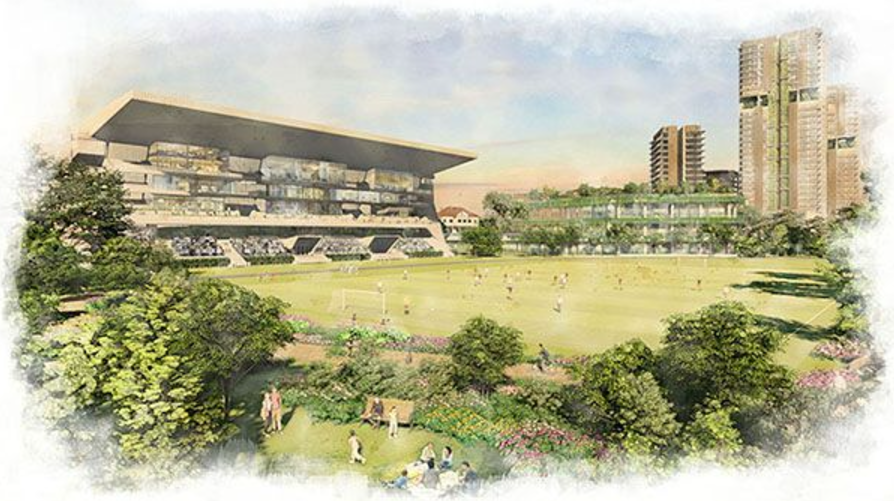Bukit Timah

📷: Artist impression of a repurposed Grandstand as part of Bukit Timah Turf City's transformation (URA)
What comes to mind at the mention of Bukit Timah? Located in Singapore’s
central region, Bukit Timah is known for its lush greenery, numerous educational
institutions, and rich history; a place where the past is integrated with
the landscape of the present.
The name Bukit Timah came from a mistranslation of the name of the Temak
tree, which can be found in abundance in Bukit Timah Nature Reserve. Bukit
translates as 'hill' in Malay, while Timah is Malay for 'tin', although
strangely enough, tin was nowhere to be found in the area!
In the 1800s, Bukit Timah was primarily inhabited by Chinese settlers
who set up gambier and pepper plantations. These plantations were replaced
by fruit and vegetable farms, and later by the cash crop of rubber by the
end of the 19th century.
During that period, the British colonial government constructed Bukit
Timah Road, which played a key role in facilitating the flow of produce
and people from plantations and rural areas to the town centre. Bukit Timah
Road also provided access to Malaya. To support increasing traffic, the
Bukit Timah Railway Station was built in 1932. These infrastructure developments
facilitated the urbanisation of Bukit Timah. While the Bukit Timah Railway
Station ceased operations officially in 2011, it was accorded conservation
status by the Urban Redevelopment Authority and
remains the only suburban station which still stands today. Frequented
by railway and photography enthusiasts, it has become a popular #heritage landmark.
Bukit Timah is also known for its rich history, having been an intense
site of conflict between the British and Japanese forces during the battle
for Singapore in World War 2. The British surrender took place at the then-Ford
Motor Factory (now known as the #FormerFordFactory in
Upper Bukit Timah Road) on 15 February 1942.
Additionally, it is hard not to notice the number of schools that line
the stretch of Bukit Timah Road, one of which includes the Bukit Timah
campus of the National University of Singapore.
Formerly known as Raffles College, it was established in 1928 as Singapore’s
second institution of higher learning. The College was the work of the
British colonial administration and philanthropists, who laid the foundations
of tertiary education in Singapore.
#DidYouKnow that
Bukit Timah was once the location of Southeast Asia’s top racecourse? The
Singapore Turf Club Racecourse operated there from 1933 to 1999, before
it relocated to Kranji. To meet the growing aspirations among Singaporeans
to live closer to their workplaces in the city, the current #BukitTimahTurfCity will
be transformed into a new housing estate over the next 20 to 30 years,
making way for about 15,000 to 20,000 public and private homes. Urban planners
have committed to ensure that homes, heritage, nature, public spaces and
amenities are sensitively integrated to provide current and future residents
a highly liveable, inclusive and endearing living environment. For example,
significant heritage buildings and structures in the area will be studied
for retention or repurposing including the iconic North Grandstand.
Bukit Timah is one of #OurNeighbourhoods which
stands at the nexus of Singapore’s past and present. Even as Bukit Timah
continues to be developed, the past is never forgotten and is integrated
into plans for the future.
What are some of your Bukit Timah memories?
#OurNeighbourhood #BukitTimah #Singapore #Heritage #SingaporeSchools

